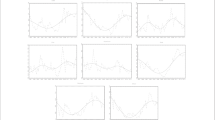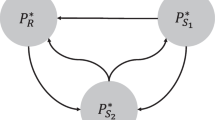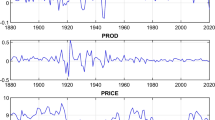Abstract
Knowing the factors that influence the secondary refined copper supply behavior has been fundamental in generating a copper market model and developing public and corporate policies. When analyzing the explanatory variables used in the existing models in the literature, it is possible to observe high variability in estimating the parameters when modifying the availability of information or changing the observation period. Based on this, we argue that only some explanatory variables will have robust estimated parameters, which means that they are unbiased, stable (i.e., they do not vary significantly when the specification of the equation or the number of observations changes), and with asymptotic convergence over time. This work defines and validates a method to select robust explanatory variables capable of quantifying the refined secondary supply of copper (or any other variable) in a given period. Using a database with 23 explanatory variables in the period 1960–2017, we characterize the estimated parameters with high and low robustness, thus supporting the proposed hypothesis. The results obtained allowed identifying those variables with low uncertainty in estimating their parameters, with a high statistical significance, and with a low standard deviation. This allows to obtain a robust function for the secondary refined copper supply in the long term, capturing essential elements of reality.








Similar content being viewed by others
Notes
This scrap has excellent quality, and in most cases, it only needs to be melted down to re-enter the economy (Tilton and Guzmán 2016).
The stability of the estimated parameter could also be influenced by the expert judgment of different econometricians.
Another way that a mathematical function could be variable over time is precisely by using models with variable coefficients (see for example Durán Santomil et al. 2011).
Different estimation techniques such as auto-regressive distributed delay models (ARDL), generalized linear models (GLM), two-stage least squares (TSLS), and author regressive moving average models (ARMA) suffer from the same problem suggested (Green 2018).
The standard deviation \((\sigma )\) is defined as \(\sigma =\sqrt{\frac{1}{N}\sum_{i=1}^{N}{({x}_{i}-\mu )}^{2}}\), where the sum of each data \({x}_{i}\) minus the sample average μ is squared and divided by the sample number N.
Fisher et al. (1972), Slade (1980), and Vial (1988) calculated the explanatory variables stock and flow of scrap, assuming that 100% of the copper that entered the market later reemerged as old scrap, without considering a fraction dissipated and lost in the process. However, it is essential to mention that calculating the flow and stock of scrap metal is much more complex (see Rivera et al. 2021), but in terms of exercise, what was existent in the literature was used.
When considering working with the dollar/euro index, a more global analysis of the market is being included, with the euro being a measure of weight that counteracts the dollar, particularly in the period 1975–2017.
White noise is a series such that its mean is zero, the variance is constant, and it is unrelated across time (Green 2018).
Null hypothesis: H0: δ = 0 (that is, there is a unit root, the time series is non-stationary or has a stochastic tendency). Alternative hypothesis: H1: δ < 0 (that is, the time series is stationary, possibly around a deterministic trend) (Greene 2018).
When the dispersion range between the variables is between 97 and 100%, it is considered a perfect linear relationship (Walpole et al. 2012).
This iteration period was considered to obtain a gradual representation; an iteration greater than 4 years probably does not show significant changes in the estimated parameter \(\left(\widehat{\beta }\right)\).
Discarding those 23 pairs of variables with a correlation coefficient greater than and equal to 97%, using the 23 explanatory variables, it is possible to build a total universe of 7,322,143 different models (\(23 \sum_{n=2}^{23}\left\{\left(\frac{23}{n}\right)-23\left(\frac{25-n}{n-1}\right)\right\}=\mathrm{7.322.143})\).
The results of all the models generated are found as an annex to the paper.
Autocorrelation occurs when the independent variables have a temporal structure that is repeated on certain periods over time. Then, today’s residuals (t) will depend on past residuals (t-1) and the assumption of independence of the classical linear model will not be fulfilled (Green 2018).
Durbin and Watson (1951) tabulated these limits for observations from 6 to 200 and up to 20 explanatory variables.
The results of all the models evaluated throughout this section are found as an annex to the paper.
Simultaneous equations contain more than one dependent variable, or endogenous, which require a number of equations equal to the number of endogenous variables, a condition that violates the strict exogeneity assumption (Greene 2018).
To verify the stability of the parameters of function 4, the CUSUM and CUSUM2 tests were performed. It was obtained as a result that there is structural permanence with 95% confidence, and there are no structural changes with 95% confidence. These results indicate that the variables selected to compose the robust model of function 4 show stability in estimating the coefficients.
References
Akaike H (1974) A new look at the statistical model identification. IEEE Trans Autom Control 19(6):716–723
Ali SA, Giurco D, Arndt N, Nickless E, Brown G, Demetriades A, Durrheim R, Enriquez MA, Kinnaird J, Littleboy A, Meinert LD, Oberhänsli R, Salem J, Schodde R, Schneider G, Vidal O, Yakovleva N (2017) Mineral supply for sustainable development requires resource governance. Nature 543:367–372
Aruga K, Managi S (2011) Price linkages in the copper futures, primary, and scrap markets. Resour Conserv Recycl 56:43–47
Ayres RU, Ayres LW y, Råde I (2013) The life-cycle of copper its co-products and byproducts. Eco-Efficiency in Industry and Science. Springer Science & Business Media (13)
Central Bank of Chile Working Papers (2005) Fluctuations of the dollar, price of the copper and terms of trade. Chile. February 2005, N.310. https://www.bcentral.cl/areas/investigacion. Accessed 26 Apr 2019
Batten JA, Ciner C, Lucey BM (2010) The macroeconomic determinants of volatility in precious metals markets. Resour Policy 35:65–71
Blomberg J, Hellmer S (2000) Short-run demand and supply elasticities in the West European market for secondary aluminum. Resour Policy 26:39–50
Bonnin M, Azzaro-Pantel C, Domenech S, Villeneuve J (2015) Multicriteria optimization of copper scrap management strategy. Resour Conserv Recycl 99:48–62
Binder CR, Graedel TE, Reck B (2006) Explanatory variables for per capita stocks and flow of copper and zinc – a comparative statistical analysis. J Ind Ecol 10:111–132
Bureau of Labor Statistics U.S. (2019) PPI Databases. www.bls.gov/ppi/data.htm. Accessed 2 Mar 2019
Christopoulos DK, Tsionas EG (2004) Financial development and economic growth: evidence from panel unit root and cointegration tests. J Dev Econ 73:55–74
Crowson P (2003) Mine size and the structure of costs. Resour Policy 29:15–36
Dickey DA, Fuller WA (1979) Distribution of the estimators for autoregressive time series with a unit root. J Am Stat Assoc 74:427–431
Durán Santomil P, Otero González LA, Fernández López S, Vivel Búa M (2011) Análisis del riesgo de renta variable en el marco de solvencia II: modelos internos frente al modelo estándar. Cuadernos de economía y dirección de la empresa 14(2):91–101. https://doi.org/10.1016/j.cede.2011.02.003
Durbin Jy Watson GS (1951) Testing for serial correlation in least-squares regression. Biometrika 38: 159-171
Fernández V (2020) Innovation in the global mining sector and the case of Chile. Resour Policy 68:101690
Fischer FM, Cootner PH, Baily MN (1972) An econometric model of the world copper industry. Bell J Econ Manag Sci 3(2):568–609
Fu X, Ueland SM, Olivetti E (2017) Econometric modeling of recycled copper supply. Resour Conserv Recycl 122:219–226
Giurco D, Petrie JG (2007) Strategies for reducing the carbon footprint of copper: new technologies, more recycling or demand management? Miner Eng 20:842–853
Gómez F, Guzmán JI, Tilton JE (2007) Copper recycling and scrap availability. Resour Policy 32:183–190
Granger CWJ, Newbold P (1974) spurious regressions in econometrics. J Econom 2:111–120
Green WH (2018) Econometric analysis, 8th edn. Prentice-Hall, Upper Saddle River
Han A, Ge J, Lei Y (2015) An adjustment in regulation policies and its effects on market supply: game analysis for China’s rare earths. Resour Policy 46:30–42
Hausman JA (1976) Specification tests in econometrics. Econometrica 46:1251–1271
ICSG (2018) Annual Recyclables Survey 2018. International Copper Study Group. Available at: http://www.icsg.org. Accessed 2 Mar 2019
ICSG (2020) Statistical yearbook 2020. International Copper Study Group. Available at: http://www.icsg.org
Junbo W, Yiyi J, Minxi W, Xin L (2019) Scenario analysis of the recycled copper supply in China considering the recycling efficiency rate and waste import regulations. Resour Conserv Recycl 146:580–589
Kuckshinrichs W, Zapp P, Poganietz W-R (2007) CO2 emissions of global metal-industries: the case of copper. Appl Energy 84:842–852
Lucas RE Jr (1976) Econometric policy evaluation: Acririque. Carn-Roch Conf Ser Public Policy 1:19–46
Mankiw NG (2017) principios de economía, Edición 7. Cengage Learning, Espeña, p 847
Northey S, Mohr S, Mudd GM, Weng Z, Giurco D (2014) Modelling future copper ore grade decline based on a detailed assessment of copper resources and mining. Resour Conserv Recycl 83:190–201
Pinho S, Ferreira M, Almeida MF (2018) A wet dismantling process for the recycling of computer printed circuit boards. Resour Conserv Recycl 132:71–76
Rivera N, Guzmán JI, Jara JJ, Lagos G (2021) Evaluation of econometric models of secondary refined copper supply. Resour Policy 73:102170
Schipper BW, Lin H-C, Meloni MA, Wansleeben K, Heijungs R, Voet E (2018) Estimating global copper demand until 2100 with regression and stock dynamics. Resour Conserv Recycl 132:28–36
Slade ME (1980) An econometric model of the U.S. Secondary Copper Industry: recycling versus Disposal. Environ Econ Manage 7(2):123–141
Sosvilla-Ramos S, Ramos-Herrera MC (2012) The US dollar-euro exchange rate and US-EMU bond yield differentials: a causality analysis. Econ NoteBook 35:117–128
Tan CS (1987) An econometric analysis of the world copper market. World Bank. World Bank staff commodity working papers. International Economics Department. Washington, D.C. 20433, U.S.A. (20):162
Tilton JE (1999) The future of recycling. Resour Policy 25:197–204
Tilton JE, Guzmán JI (2016) Mineral economics and policy. Resources for the Future Press, New York
Valencia C (2005) An econometric study of the world copper industry. Ph.D. Dissertation, Colorado School of Mines, Golden, CO
Vial J (1988) An econometric study of the world copper market. Ph.D. Dissertation, University of Pennsylvania, Philadelphia, PA
Walpole RE, Myers RH, Myers SL, Ye K (2012) Statistics and probability for science and engineering, 8th edn. Pearson Education, México S.A. of C.V, p 816
Wang M, Chen W, Zhou Y, Li X (2017) Assessment of potential copper scrap in China and policy recommendation. Resour Policy 52:235–244
Wang J, Yiyi J, Minxi W, Xin L (2019) Scenario analysis of the recycled copper supply in China considering the recycling efficiency rate and waste import regulations. Resour Conserv Recycl 146:580–589
Xiarchos IM, Fletcher JJ (2009) Price and volatility transmission between primary and scrap metal markets. Resour Conserv Recycl 53:664–673
Acknowledgements
All persons who have made substantial contributions to the work reported in the manuscript (e.g., technical help, writing and editing assistance, general support), but who do not meet the criteria for authorship, are named in the Acknowledgements and have given us their written permission to be named. If we have not included an Acknowledgements, then that indicates that we have not received substantial contributions from non-authors.
Author information
Authors and Affiliations
Contributions
Category 1
Conception and design of study:
Nilza Rivera, Juan Ignacio Guzmán, Gustavo Lagos
Acquisition of data:
Nilza Rivera, Juan Ignacio Guzmán, Gustavo Lagos
Analysis and/or interpretation of data:
Nilza Rivera, Juan Ignacio Guzmán, Gustavo Lagos
Category 2
Drafting the manuscript:
Nilza Rivera, Juan Ignacio Guzmán, Gustavo Lagos
Revising the manuscript critically for important intellectual content:
Nilza Rivera, Juan Ignacio Guzmán, Gustavo Lagos
Category 3
Approval of the version of the manuscript to be published (the names of all authors must be listed):
1. Nilza Rivera
2. Juan Ignacio Guzmán
3. Gustavo Lagos
Corresponding authors
Ethics declarations
Conflict of interest
The authors declare no competing interests.
Additional information
Publisher's note
Springer Nature remains neutral with regard to jurisdictional claims in published maps and institutional affiliations.
All persons who meet authorship criteria are listed as authors, and all authors certify that they have participated sufficiently in the work to take public responsibility for the content, including participation in the concept, design, analysis, writing, or revision of the manuscript. Furthermore, each author certifies that this material or similar material has not been and will not be submitted to or published in any other publication before its appearance in the Resources Policy, the International Journal of Minerals Policy and Economics.
Rights and permissions
About this article
Cite this article
Rivera, N., Guzmán, J.I. & Lagos, G. A method to estimate the robustness of the secondary refined copper supply function. Miner Econ 36, 255–277 (2023). https://doi.org/10.1007/s13563-022-00308-4
Received:
Accepted:
Published:
Issue Date:
DOI: https://doi.org/10.1007/s13563-022-00308-4




